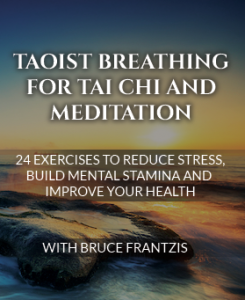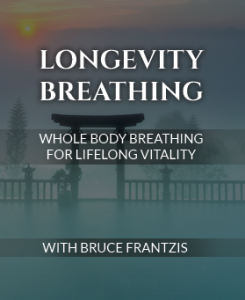The simple fact is that most people do not breathe well. There are numerous studies on the effects of poor breathing on your health. When a person doesn’t breathe well it contracts their body, and induces tension and stress . . . so learning to breathe well is very important to solving this major health problem.
Why do we breathe poorly and what is the cause?
First we must explore the basics of breathing. How does your body actually take a breath? From your lungs? You may be surprised to learn that breathing does not start from your lungs. The lungs are the sacs that fill up with air as your diaphragm is pushing in or out. It is actually your diaphragm that CAUSES the air to go in and out of your lungs.
As people age their breathing tends to get worse. Many years of habitual shallow breathing causes the diaphragm to spasm. It’s similar to a hand that tenses and spasms. For many people, the diaphragm isn’t a smooth running muscle. Instead, it’s under immense tension, and very often it flutters.
When the diaphragm flutters it causes you to involuntarily hold your breath. Most of the time you don’t even know you’re doing it.
There are many other causes for holding of the breath. When we have strong emotional outbursts, or tensions we can easily recognize that we hold our breath. But, what is interesting is that many people hold their breath while they go about their normal activities. It is due, at least in part, to diaphragm spasms and also to lack of awareness on how to properly breathe.
So, an important component of breath training is getting your diaphragm to relax by working on it sufficiently, and by consciously making the motion of the diaphragm comfortable and smooth. This takes practice.
Taoist Longevity Breathing Exercise
The movement of the diaphragm is critical to having good general breathing, and is absolutely necessary for breathing with your lower belly in Taoist Longevity Breathing. If your diaphragm is extremely tense, your breath will not penetrate your internal organs and go all the way to the bottom of your belly, and then move on to your sides and your kidneys. It definitely won’t happen while you have involuntary spasms.
The degree to which you can release these involuntary spasms, the better will be your breathing. It can become dramatically better just by working the diaphragm more and making your breath comfortable and smooth. A positive feedback loop is also created as the ability of your body to naturally relax will also be enhanced.
To get the diaphragm involved in Longevity Breathing, put your fingers on your diaphragm—right at the bottom of your sternum and where your rib cage starts. With your fingers in place, breathe in and breathe out. You might feel that there is a short, stop-start-stop-start. Just become aware of it and try to overcome it. Put your awareness in your diaphragm. Slow down your breathing and breathe in less.
You still inhale and exhale without stopping, but each time you consciously relax your diaphragm. Keep practicing until the pain or the pressure you feel from your fingers on your diaphragm begins to naturally diminish. Please click here to read Longevity Breathing: A Wise Man Breathes From the Heels and learn more about Taoist Breathing.
If you want to make this a habit then you will want to do this practice over and over again until your fingers being in your diaphragm no longer causes pain. Do it over and over again until the motion doesn’t have a start-stop quality as your diaphragm goes up and down.
Eventually the motion will become smooth and comfortable. Getting your diaphragm moving properly is one of the most important things you can do for your health and for life.





Hi, thanks for that.
Firstly, please be more specific on how we’re putting the fingers on the diaphragm, are we pushing in under the ribs, and if so (to get pain!), how far?
Breathing is super important, you can live for 2 weeks without food, 2 days without water though only 2 minutes without air.
Thanks, Merlin
You are pushing the fingers in below the ribs (where the diaphragm is) deep enough to where you can feel the pressure differential between the diaphragm and the skin. You could use the side of your hand, your fingers, or any other part as long as you can get in deep enough.
Very GOOD to know my friend :)> I have this problem ..but have been working on it for a few months!! it REALLy works!! I did it because My LOWER BACK and tail bone were in pain…felt like a Warm Tingling/burning Sensation!! I’m curious When breathing in thru the Nose…how long should i hold my breath..until i exhale out of my mouth..someone told me 7 seconds inhale then hold for 10 seconds…
Thanks for sharing this useful information on breathing. I often watch how others breathe and notice their shallow breath. Is there a website or journal where I can get more information on the American Medical Association statistics on breathe as mention at the beginning of your blog? I am a medical social worker and would like to use the information when I teach tai chi/qigong to staff and patients. Thanks.
Hi Rob,
Bruce mentioned he heard this on a PBS special (3 or 4 times) but we have been unable to find the exact source so we have removed the reference. If you google breathing research and studies there are numerous studies on the net. In terms of the AMA we were able to find studies relating to asthma and other diseases…
Thanks,
Website moderator
On behalf of Bruce
Looks like you need a bigger surf board 🙂
Master BK
Im beginning to learn the Hun Gar Tiger Crane form
Would You be so Kind as to give Me Your opinion on the essence of Tiger Movement ,Breathing and energy.
Thank You
namaste
David
Excellent piece – short, pithy, useful. I am convinced that, for me, there is an absolute one-to-one correlation between tension in the body and lousy feelings – depression (to which I’m unfortunately prone), anxiety (less prone but still get a fair amount of it), fear, etc. I’ve learned that if I can disconnect the tension I can disconnect some of the lousy feelings. Just now I was feeling very sluggish. I found some massive tension in my diaphragm and focused on my breath and relaxing that tension. My mood lifted very quickly. I’m definitely just a beginner at breathwork/bodywork (well, let’s say, an intermediate) but I certainly see the value. Maybe in my next lifetime I’ll get going on this stuff in my teens rather than my 40s!
Hi,
I regognize myself in Bob. Making the excersizes now. Few question:
– What doe you mean with “stop-start-stop-start”?
– how many times per day to do this excersize?
– The area between my sternun and belly button is tense, sort of cable. Is this due to the diaphram spasm?
Thanks!
May I also suggest magnesium supplementation, as well as Bruce’s touch sensing? Magnesium relaxes smooth muscle, and the diaphragm is a very large smooth muscle. Most people are lacking in magnesium, especially as they grow older.
Be warned that magnesium has a laxative effect, which is why it is often used for constipation. (Milk of Magnesia, anyone?). It works because the intestines are also composed of smooth muscle.
Magnesium is usually combined with Calcium and Zinc (also lacking in modern diets), and sold as “Cal-Mag-Zinc.”
I don’t understand what you mean by feeling the “pressure differential between the diaphragm and the skin.” Could you please explain? And are the fingers supposed to feel this? Thanks.
my partner has a paralyzed diaphragm on one side …will ti chi help to to re start it told?
I am a female almost 75 years old. For about a year or so I have had a severe tightening across my diaphragm as if my bra was too tight….even when I am not wearing one. None of the doctors I have seen have been able to diagnose it. I wouldn’t describe it as pain, but extreme discomfort, especially when sitting, sometimes worse than others but constant. I often feel it is going to suffocate me or break my ribs, but I’m not the panicky type. I feel my diaphragm is indeed “frozen”. Any suggestions for someone my age. I’ve also had open heart surgery but that was a breeze.
Yh, very gd piece here. Im 24 had anxiety n depression for a couple of yrs now. When i get my diaphragm going i feel so relaxed and on top of the worldand feel normal.but when i cant feel it moving and i shallow breathe its annoying. Will work on this 1though thanx. Also ppl imagine like a tredmill in your stomach jus keep it running hope it works for someone.
EXHALE FIRST. suck in your gut (exhale) causing fresh air to fill the lungs,restoreing normal breathing. works every time,even on a crowded buss.REMEMBER–EXHALE FIRST. have agreat day
Thanks. That was extremely helpful Jim
Fine way of describing, and pleasant post to get data regarding my presentation topic, which
i am going to present in academy.
Thanks for this info. I have had this problem a few weeks. And I was getting panicky. I will try the exercise
VERY happy to find this article. Was looking for ways to relax the diaphragm since a while and this makes a lot of sense. Recently not quite enjoying waves of anxiety, and last week throwing up literally with the knot in the solar plexus. Just now investigating the area it seems more at the right side. Hopefully my digestion (despite daily breathing exercises having excessive amounts of air going up or down) will improve with this also. Thank you very much!!!
I’d suggest Rolfing, because it works your whole body and increases awareness, and it’s a gentle technique
I am exactly in the same situation. I hope yours has improved
Thank you so much!! I’ve been Focusing on why my shoulders and back ache, and my erector spinae muscles are chronically tight. Every time I ask my body what needs to hapen for it to release and relax these muscles, my body keeps bringing me right back to a fluttering feeling below my rib cage. I eventually realised it was some sort of spasm in my diaphragm.
Your post is so helpful, because it confirms what I felt internally. That I need to relax my diaphragm through fluid and relaxed breathing.
As a child under the age of 3, I had several operations where osophagul tubes were inserted into my stomach and my stomach pumped of its contents. I think this was the initial cause of tension in my diaphragm but I’ve never really been aware of it until now. Instead I’ve lived with backache and anxious feelings.
Thanks Again
I have the exact same feeling as you. Did this fix it? Because i feel like i already breath exactly how i should but one side of my diaphragm just stays frozen and causes extreme painful tension on the same side of my neck and shoulder.. and doing breathing exercises only makes my tightness worse. Most of the time it feels like im only breathing through one side of my body
I’m a young guy with diaphragm tension and anxiety. This really helped me. Thank you.
Wow this is exactly what I’ve been suffering from. Have seen the ER many times last few months. Being unable to breathe. I thought I was dying! Or had pneumonia since covid 19 is here. But they couldn’t find a thing wrong with me. While I was gasping for air. Now I think my diaphragm is the cause. It makes me go in to full blown panic attacks. While I’m not the panicky kind. I hyperventilate like crazy as well. New to me. Last few months have been a struggle and battlefield cause of shortness of breath.
This works! Been suffering the diaphragm cramps and tight feeling for 6 months. Neither Pulmonologist or ENT had a clue ( disappointing) as I was being treated for a lung and sinus issue and mentioned it to them a number of times. I started the breathing exercises and almost immediately felt relief. That was a week ago and still doing the exercises every day and feeling much better. Thank you so much!